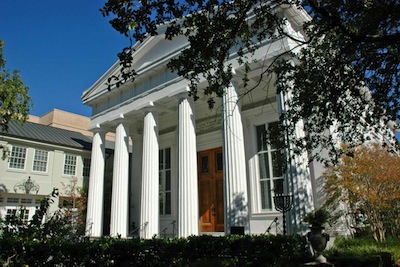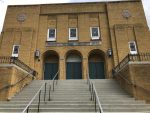The Orthodox synagogue Brith Sholom Beth Israel. (photo from jsilverman.weebly.com/synagogues-in-charleston.html)
Charleston, S.C., is one of the most popular travel destinations in the United States. With its perfectly preserved old mansions, Charleston has charm and grace, in addition to genuine human warmth. Just walk along any of its streets and the first person you meet will surely give you a friendly hello.
Jews have resided in Charleston since 1695, attracted by economic opportunities and its proclamation of religious liberty for all. In 1749, there were enough Jewish pioneers in town to organize a congregation, Beth Elohim, the second-oldest synagogue in the country (now Reform) and the oldest in continuous use. Its imposing colonnaded neo-classical structure on Hasell Street was designated a National Historic Landmark in 1980.
The congregation’s small museum features the historic 1790 letter that George Washington wrote in response to the synagogue’s good wishes upon his becoming president: “May the same temporal and eternal blessing which you implore for me rest upon your congregation.”
This letter is emblematic of the spirit of friendship between the gentile establishment and Jews – and the acceptance, even early on, of Jews into the American mainstream, especially in the South. (More than 20 Jews from Charleston fought in the American Revolution and one, Francis Salvador, was a delegate to several Provisional Congresses. This may explain the friendly link between George Washington and the Charleston Jewish community. And, besides, Washington was known as a decent and courtly man.)
During the first decade of the 1800s, Charleston, with its 500 Jews, almost all of them Sephardi, was considered the largest, most cultured and wealthiest Jewish community in America. But, because of the destruction of the city during the Civil War, the city and its Jews became impoverished, and the waves of Jewish immigration in the 19th and 20th centuries passed it by. However, after the Second World War, the city prospered, as did its Jews. Today, the nearly 2,000 Jews in the city are in the professions, trade and business, teaching, politics and the arts. In the 1920s through the early 1950s, the city’s main street, King Street, was virtually shut down on Saturday. Walk along King Street today and you will still see many Jewish names on the shops.

In addition to three synagogues, one each from the major branches of American Jewry, there are a number of Jewish philanthropic and communal organizations, a Jewish community centre and a well-established day school.
The College of Charleston, the oldest municipal college in the United States, also has a broad-ranging and ever-growing Jewish studies program under the devoted and imaginative direction of Prof. Martin Perlmutter – now with its own building, thanks to the generosity of Henry and Sylvia Yaschik. The 800 Jewish students make up a significant minority of the college population. In addition to an active Hillel, the array of courses includes Hebrew language, Jewish culture and history and Israel- and Holocaust-related courses.
What makes Charleston especially attractive is its visible Jewish history, coupled with the world-class arts festival Spoleto USA, which runs for about two-and-a-half weeks every year, from the end of May to early June. The festival is an all-encompassing cultural experience: opera, dance, theatre, jazz and classical music, popular music, even acrobatics. The twice-daily chamber concerts, at 11 a.m. and 1 p.m., hosted with humour and panache by first violinist of the St. Lawrence Quartet, Geoff Nuttall, are considered the musical anchor of the festival.
But there is more. The Piccolo Spoleto Festival, sponsored by the City of Charleston, which runs during the same two-and-a-half weeks, offers a dizzying array of classical music, plays, cabaret and comedy acts, jazz cruises and much, much more. The College of Charleston’s Jewish studies unit also sponsors several events during the festival, including A World of Jewish Culture.
This year, the Orthodox synagogue Brith Sholom Beth Israel, on Rutledge Avenue, hosted four evenings of chamber music, featuring Jewish composers like Kurt Weill, George Gershwin, Paul Ben-Haim, Ernest Bloch and Eric Korngold, and non-Jewish composers who wrote Jewish music, like Ravel’s “Kaddish” and Max Bruch’s “Kol Nidrei.”
In Charleston, too, lived the people who inspired Porgy and Bess, by George and Ira Gershwin. The Gershwins resided temporarily on James Island, just outside the city, while writing their opera. They purposely came to Charleston to get a feel of the city, its ambience and its people. One of the great tunes in Porgy, of course, is “Summertime,” with its Yiddish-sounding melody in a minor key.
Charleston also has a Conservative congregation, and the three Charleston congregations – Reform, Conservative and Orthodox – are unique in that their rabbis cooperate for the greater good of the community and even meet once a month for lunch and a study session. Another fascinating crossover is that many Jews in the community belong to more than one shul – a kind of anti to the old joke about the Jew on the desert island who builds two shuls. When asked why, he responds, “That one, I daven in; the other, I wouldn’t be seen dead in.”
One longtime Jewish resident, a spry and active octogenarian agnostic proudly and only half-facetiously remarked, “I belong to all three shuls, thank God, but you won’t catch me praying in any of them.” And when he was indeed caught one Sabbath morning davening in the Orthodox shul, one of his pals came up to him and joked, “What are you doing here? Today’s not Yom Kippur.” In response, the 80-year-old quipped in his slight Carolina drawl, “Well, then I hope God forgives me for coming today.”
At the College of Charleston during the academic year, there is a kosher dairy cafeteria, Marty’s Place. And Chabad has pre-packaged prepared meat meals that are available at the famous Hyman’s Fish Market on King Street. For delicious vegetarian meals at reasonable prices, go to Jon York’s Gnome Cafe, at 109 President St.
Be sure to also take a horse-and-buggy ride in the historic district. The knowledgeable guides will take you through the residential part of town, focusing on the homes and the history of their occupants. Then stroll along the quiet streets, in the famous covered market, and tour the nearby plantations.
Two useful telephone numbers are those of the Charleston Visitors Bureau, 1-800-774-0006, and Spoleto’s, 1-843-579-3100 or spoletousa.org.
Curt Leviant’s most recent books are the critically acclaimed novels King of Yiddish and Kafka’s Son.

